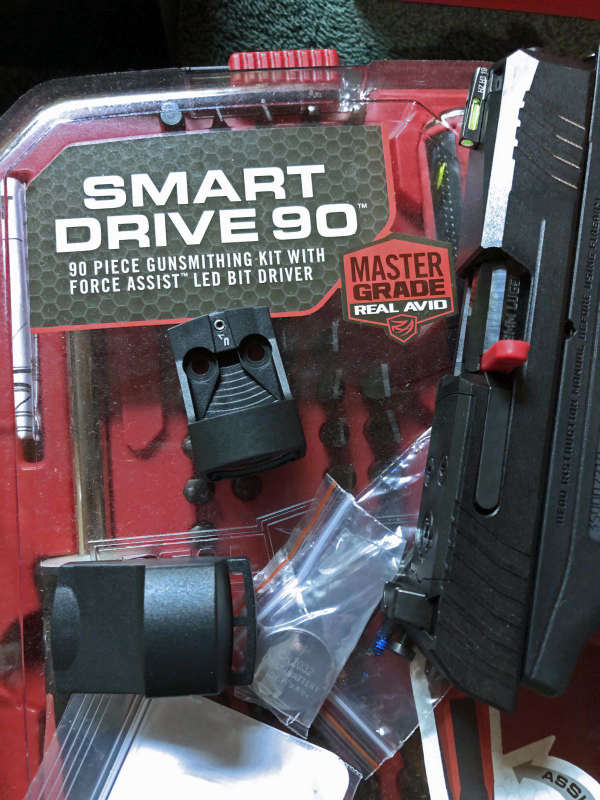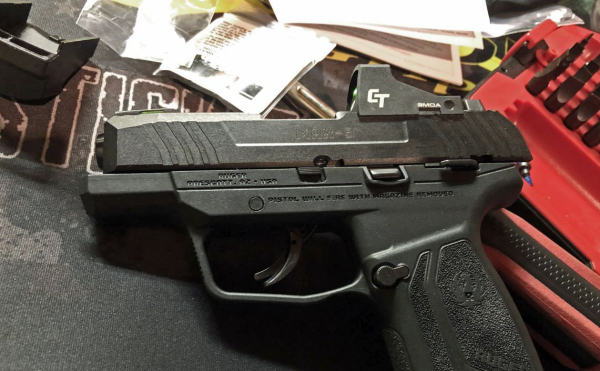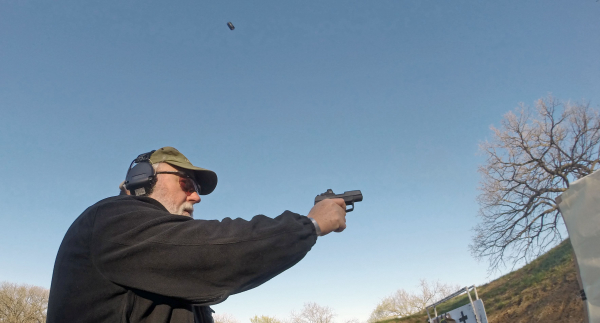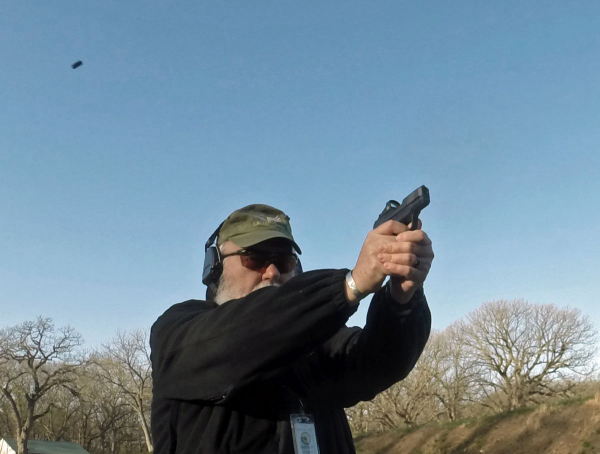We looked at the Ruger MAX-9 moderate-capacity micro-9 here. A personable little gun, it has the bark of short barrel 9x19mm pistols with little bite. Remarkably, it’s optics ready. That’s something for this form factor and especially interesting at the price.

The Crimson Trace CTS-1550 arrives with mounting screws, mounting wrench, sight adjustment tool (the same as with the firm's Laser Grips) and a cover that shuts the optic "off."
|
Who needs glass on a gun this small? Well, some people who carry something like this may have compromised vision, be duffers or perhaps want to flatten the learning curve for a gun handler new to defensive pistols.
I contacted Crimson Trace in advance of their new optics line, as I was willing to wait. Instead, they quickly shipped a CTS-1550 from their facility in Missouri. A 3MOA red dot sight, the CTS-1550 is a ‘base model.’ It uses an exposed emitter with ambient light detection to adjust the reticle’s brightness. The device is “off” when you attach the included cover.
In keeping with the mission – light weight, small form factor – the CTS-1550 is very light and features polymer construction. It’s less for the ‘duty class’ in exposed holsters and more for concealed carry and range use.
The battery – rated for potentially 20,000 hours of use – is mounted under the optic; you have to remove it to replace the battery. Doing an annual maintenance routine on the MAX-9, including a good cleaning and battery-change would be smart. The battery placement puts the reticle low – with the mounting situation on the Ruger, this allows a co-witness with the supplied sights. The CTS-1550 is notched for just such use.


Following Ruger’s instructions – and having checked the Crimson Trace manual as well -- it was little work to install the Crimson Trace CTS-1550 optic on the Ruger MAX-9. I had only to remove the top slide cover plate, install the two spacing pins and drop the sight right into the slide using the supplied screws. While knowing it’s not considered smart to ‘slave the dot to the iron sights,’ I could see the factory Ruger sights through the optic and put the dot atop the front sight in advance of a range trip.
At the range, I used ASYM 115 grain JHP Match to zero the gun. From ten yards, I saw I was low. I dropped back to 25 to check and it seemed I was still a little low on the target. Using the professional technique known as SWAG, I gently adjusted the Crimson Trace dot “up.” I confirmed my corrections at 25 yards. While I was striking slightly right at 25 yards, I figured that was likely a grip anomaly of my own on the small moderate-capacity pistol.
The glow of the dot in the early morning sun made the image a little fuzzy. I shot through it. Using the same short “qual” course as listed here – with the same ammo as used for the slick-top MAX-9 and the Springfield Armory Hellcat RDP – I had one low hit just below the abbreviated FBI-QIT99 bottle. It’d have been “in” on the old FBI-Q, but still unsatisfactory.


That left a 96% score on the course. While the target featured evenly scattered hits, I believe it may be grip and not the gun. The hits to the “small scoring area” in the headbox were nicely centered. That included one-handed shooting and the punctuation of the failure drill from seven yards.
The optic rides low enough on the Ruger MAX-9 that I rarely missed the dot. The single time out of 25 rounds I didn’t find it, I simply used the sights and hit center – and that was from 25 yards.
The CTS-1550 is a good addition to the Ruger MAX-9. It’s not required, but it’s handy and it’s quick. And soon Crimson Trace will have additions to their line of red dot sights; stay tuned.
- - Rich Grassi